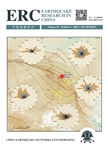Research of Source Parameters of the Yutian Ms7.3 Earthquake in Xinjiang on February 12, 2014
Research of Source Parameters of the Yutian M_S7. 3 Earthquake in Xinjiang on February 12,2014作者机构:Earthquake Administration of Shandong Province Jinan 250102 China Institute of Disaster Prevention Sanhe 065201 Hebei China
出 版 物:《Earthquake Research in China》 (中国地震研究(英文版))
年 卷 期:2016年第30卷第1期
页 面:33-42页
核心收录:
学科分类:070801[理学-固体地球物理学] 07[理学] 0708[理学-地球物理学]
基 金:jointly sponsored by the National Key Technology R&D Program of China(2012BAK19B04-01-05) the Youth Earthquake Situation Tracking Program of China Earthquake Administration(2015010106)
主 题:Apparent stress Yutian Ms7. 3 earthquake Corner frequency Sourceparameter
摘 要:The Ms7. 3 earthquake occurred in Yutian, Xinjiang on February 12, 2014. Based on seismic waveform data before the earthquake and aftershocks of the earthquake sequence, which were recorded by the Xinjiang Regional Digital Seismic Network, this paper corrected instrument response, propagation path and site response of the S-wave recording spectra. We then calculated with genetic algorithms, on the basis of the Brune model, the source parameters of the 102 M, ≥ 3. 0 Yutian earthquake sequence, seismic moment, apparent stress and corner frequency. The results show that, seismic moment of the earthquake sequence is between 3. 46 × 10^11 -2. 08×10^15N.m, apparent stress is between 1.48 × 10^5 -1.16 ×10^6Pa, mean stress level is 0. 31MPa, and corner frequency is between 1.4-7. 1Hz in the range of 3. 0 -5. 0. By analyzing the apparent stress and corner frequency variation with time, we obtain that apparent stress of earthquakes before the Yutian Ms7. 3 earthquake was significantly higher than the aftershock sequence, but the corner frequency was significantly lower than the aftershock sequence. Apparent stress was at a high level before the main shock, which shows that the main shock zone accumulated higher stress, and then the apparent stress was reduced. The main shock occurred in the process of slow increase. Because of the release of a large amount of stress, after the Ms7. 3 earthquake, the apparent stress was gradually reduced. That was the performance of low stress fracture of aftershocks.



